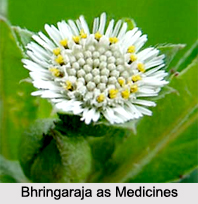 Bhringaraja is an important Ayurvedic herb, widely used in hair fall treatment, liver disorders, skin diseases etc. Its botanical name is Eclipta prostrata. Its whole plant is used for various medicinal purposes. In tattooing, the natives after puncturing the skin rub the juicy green leaves of Eclipta prostrata over the part; which gives the desired indelible colour, namely a deep bluish black.
Bhringaraja is an important Ayurvedic herb, widely used in hair fall treatment, liver disorders, skin diseases etc. Its botanical name is Eclipta prostrata. Its whole plant is used for various medicinal purposes. In tattooing, the natives after puncturing the skin rub the juicy green leaves of Eclipta prostrata over the part; which gives the desired indelible colour, namely a deep bluish black.
Heath Benefits of Bhringaraja
The leaves which have a slight camphoraceous taste are considered tonic, alterative and useful in cough, cephalalgia, skin diseases and alopecia. The juice of the leaves is much used as a snuff in cephalalgia and in soaking various sorts of powders for the preparation of pills. The leaves of both these plants are used in various ways for the purpose of dyeing grey hair and for promoting the growth of hair.
Dose of Bhringaraja in Medicine
Jatiphaladya Churna: Take nutmeg, baberang seeds, plumbago root, flowers of Tabernaemontana coronaria (tagara), sesamum seeds, leaves of Pinus Webbiana (talisa), red sandal wood, ginger, cloves, cumin seeds, camphor, chebulic and emblic myrobalans, black pepper, long pepper, bamboo-manna, cinnamon, cardamom, tejapatra, and the flowers of Mesua ferrea (nagakesara) each 2 tolas, powdered leaves of Wedelia calendulacea 56 tolas, sugar in quantity equal to all the above ingredients. Powder these and mix. Dose should be about a drachm. This preparation is said to be useful in phthisis, cough and catarrh.
Shadbindu Taila: Take sesamum oil 4 seers, goat"s milk 4 seers, juice of bhringaraja leaves 16 seers and prepare an oil with a paste composed of the following substances, namely, root of castor oil plant and of Tabernamontana coronaria (tagara), dill seeds, Caelogyne ovalis (jivanti), Vanda Roxburghii (rasna), rock salt, Wedelia calendulacea (bhringaraja), baberang seeds, liquorice root and ginger, all in one seer. 6 drops of this oil, drawn in through the nostrils, are said to relieve headache and other affections of the head.
Bhringaraja Taila: Take sesamum oil 4 seers, juice of Bhringaraja leaves 16 seers, iron rust, the three myrobalans and the root of Ichnocarpus frutescens (syamalata), reduced to a paste, all in one seer and prepare an oil in the usual way. This oil is said to remove scurf from the head, turn grey hairs black and cure alopecia.
The fresh juice of the leaves of Eclipta prostrata, is rubbed on the shaven scalp for the purpose of promoting the growth of hair.
Related Articles
Ayurveda
Ayurveda Medication
Elements of Ayurveda
Concepts of Ayurveda
Ancient Literature of Ayurveda
Sushruta Samhita
Classification of Medicine
Properties of Material Objects and its Effect on Human Body




















